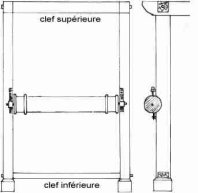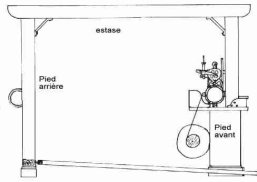- Home
- Resurrection ▾
-
Learn ▾
- Free library
- Glossary
- Documents
- Initiation
-
Shaped fabrics
- Introduction
- Popularization
- Definitions
- Le métier de façonné
- Principes du façonné
- Mécaniques de façonné
- Le jeu des crochets
- Les cartons
- Chaîne des cartons
- Mécanique 104 en détail
- Pour en finir
- Montage façonné
- Empoutage 1/3
- Empoutage 2/3
- Empoutage 3/3
- Punching, hanging and dip
- Autres façonnés
- Façonnés et Islam
-
Cours de tissage 1912
- Bâti d'un métier
- Le rouleau arrière
- Les bascules
- Formation du pas
- Position de organes
- Mécanique 104 Jacquard
- Fonctionnement 104
- Lisage des cartons
- Le battant du métier
- Le régulateur
- Réduction et régulateur
- Mise au métier d'une chaîne
- Mise en route du métier
- Navettes à soie
- Battage
- Ourdissage mécanique
- Préparation chaînes et trames
- Equipment ▾
- Chronicles ▾
- Fabrics ▾
- Techniques ▾
- Culture ▾
- Language ▾
In all looms, the yarns which are arranged in the direction of the length of the fabric are referred to as warps. This chain whose number of wires varies according to the type of fabric is folded (wound) onto a large wooden cylinder called chain roll or beam, which is placed on two supports fixed against the rear legs of the loom. By unwinding from the rear roller the warp is extended throughout the length of the loom and the interval between the warp roller where the threads are passed takes the name of length. In the length, all the threads are interlaced, that is to say crossed on two flat or round strips of polished wood, called rods or rods, this encroachment being done in the following way: the odd threads are passed over Of the first rod and below the second rod, the even yarns being passed inversely below the first rod and above the second rod, the first rod being naturally that which is behind, warp.
The encroachment of the threads of the warp on the rods has for purpose:
To preserve for the threads the place which has been given them to the warping
To allow the weaver to easily find the location of a broken yarn during weaving
To suppress the outfits caused by the threads which, in the arm warping in particular, are grouped by musette.
In certain cases, when the threads of the warp are very numerous and tight, it may be useful to arrange them on two pairs of rods by two threads which are turned to the first pair underneath and two threads to the second pair situated above. This kind of scope is referred to as double-sided.
In other cases it is also necessary to place an additional rod called a counter-rod, the purpose of which is to detach the outfits which may form in front of the yards, that is to say, behind the shed body.
The warp, while unwinding from the rear roller, is held taut by means of which the device is very variable, which are arranged under the name of flip-flops in general.
To produce the fabric it is necessary to actuate the threads and to pass them alternately either above the weft or below. For this purpose, special devices are used, which are healds for plain or armored fabrics, links for shaped fabrics.
The threads are passed according to a fixed order in relation to the number of threads and the type of fabric to be produced. These healds or links, which together form the shed body or the link body, are placed in front of the loom at about 60 cm from the feet, their movement being given by special organs which take the name of taffeta movement , Armor mechanics, dobby, and mechanics.
In front of the shed body or the link body, all the wires pass through the comb formed by steel strips between which the wires are arranged. This comb is mounted on the wing which drives it in a recoil movement which is caused by the worker either automatically with the aid of a walker or with the hand. The role of the comb in looms is threefold:
Distribute all the threads regularly in the width that the fabric should have
Serve as a guide to the shuttle in its journey through the wires
Packing the weft to form the fabric
The gap between the shed or link body and the woven part is referred to as the mede, the space in which the comb carried by the sley moves.
The woven fabric wraps on a roll placed in front of the loom and which takes the name of roll of cloth. This winding of the fabric, which must be done regularly as the weaving is carried out, is guided by an apparatus called a regulator which controls a roll of fabric by means of a series of pinions and toothed wheels.
The hand loom regulator is fixed to the front right foot of the loom and rests on the bank. The roll of fabric is therefore supported on the right side by the regulator and it is held on the left side by a support called a tab which is fixed against the front left foot of the loom.
The unwound cloth which is in front of the comb is called the molding and in some cases there is a small-diameter roller carried at its two ends by supports fixed generally to the banks. This small roller, called the roller, permanently keeps the cut at a constant height, regardless of the amount of woven fabric. In certain fabrics, such as velvet, the fabric can not be wound under tension, it is then driven by a roller whose periphery is emerged and armed with small needles arranged in a certain order and referred to as a stitched roller and emery. The fabric wraps around ¾ of the circumference of the roll and then bends underneath in a box or wraps on a small tensioned roll underneath the banks.
This disposition is general, whatever the system of the trade, and the kind of material to be executed.

The two hind feet are firmly connected to their base by an assembled and bolted transom that takes the name of clear. The two front feet are reinforced at their lower part to a height of about 70 cm, on this part rests a hardwood tray referred to as a bank, after which different organs are attached which vary according to the organization of career.
On the bank and in front of each foot is the caissetin, a small box used by the worker to deposit the cans, etc., and which is usually covered by a small board. Against and inside the 2 front feet and about 50 cm from the ground, 2 movable and adjustable supports are often attached, called mumps, which are intended to support the bench on which the worker rests in the weaving of certain Categories of fabrics.
All the craft frames, although they are always composed in the same manner, are not constructed as solidly as that shown in Figs. 1 and 2. This craft was formerly much used at Lyons, where the beautiful and strong materials are woven, demanding for their proper performance a very strong and well-assembled frame, not vibrating during the march of the craft.
It is not essential to make a good material to have a craft very well constructed and having good appearance, it is enough simply that the pieces of wood are strong enough, suitably assembled to receive the organization that is requested for the kind of Fabric to be executed.
Building a craft
The wooden framework on which all the organs of the loom are placed or fixed are called constructions. This framework, in hand looms, consists of 9 large pieces of squared and erected timber, and joined by means of tenons taken in mortises and fixed with assembly bolts.
Four of these pieces of wood placed vertically and generally measuring from 1m 80 to 1m 90 are referred to as foot craft. At their ends, these 4 feet are connected by 4 crossbars which fix the spacing of the feet to their upper part. Two of these crosspieces called estases connect two by two the front feet of the loom and the corresponding feet placed back determine the length of the loom. This length may vary according to the space available and the type of fabric to be made, generally this length is between 2 m and 2 m 50, and is measured between the front and back feet.
At their extremity the estases are connected by two strong cross-beams called keys, which determine the width of the loom. This width varies and depends mainly on the width of the fabric to be made, it must be for the loom at least 30 cm larger than that of the fabric. This measurement is also taken inside the feet.
Crafts measuring from 1 m wide up to 3 m and more are built.

Practical hand weaving course
Lyon Municipal Weaving SchoolProfessor A.CREPT - Year 1912-1913
The handwritten course has been copied by us.This hand weaving course on looms was used until the 1980s.
